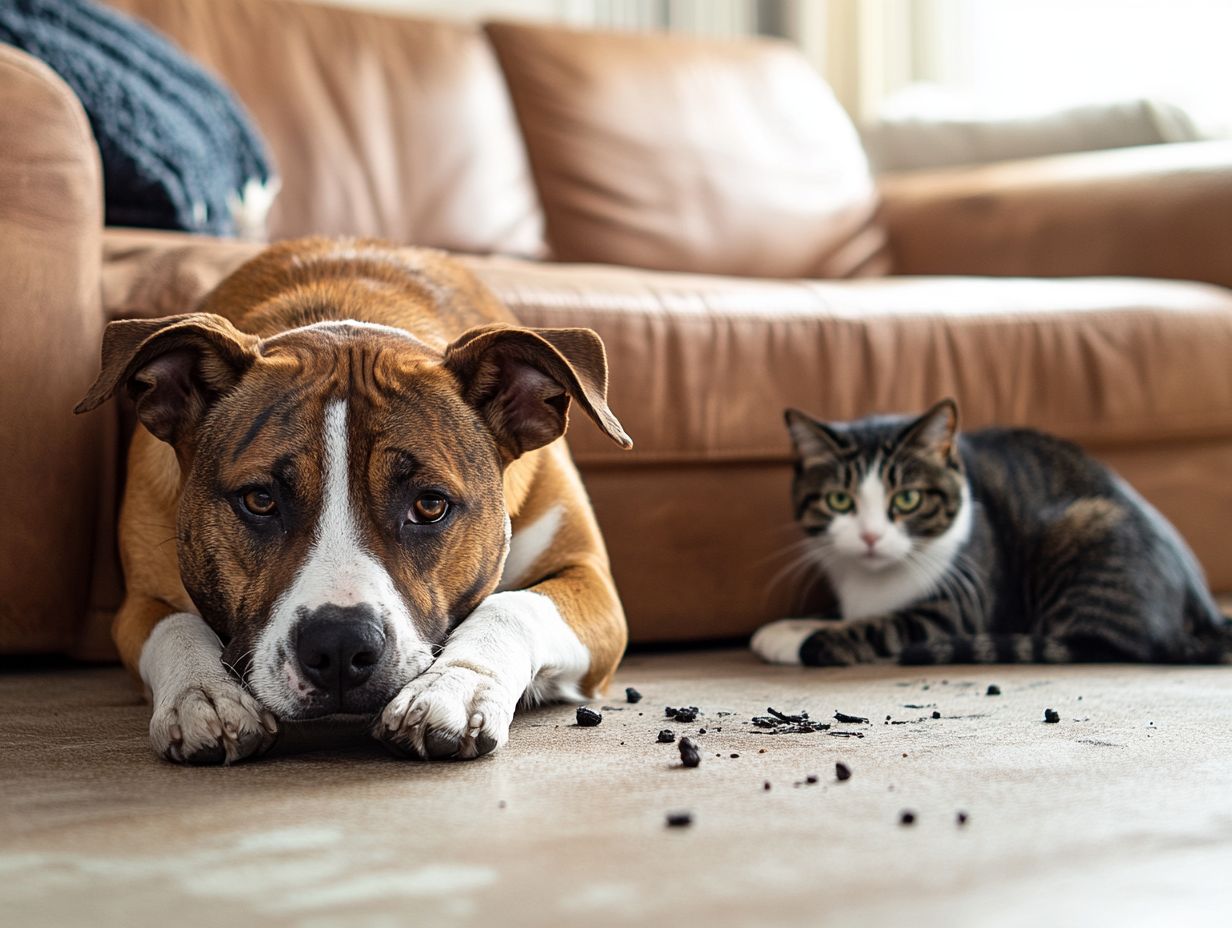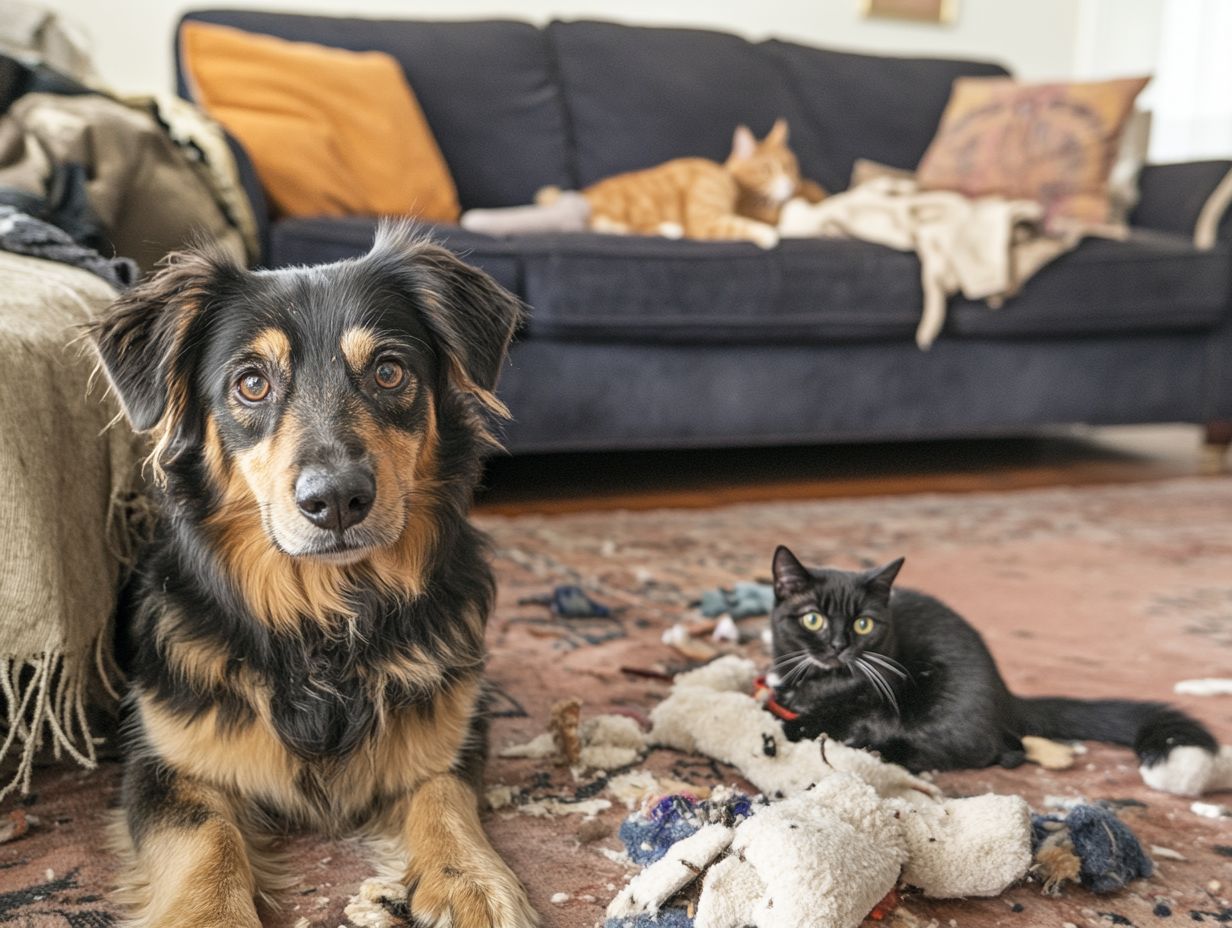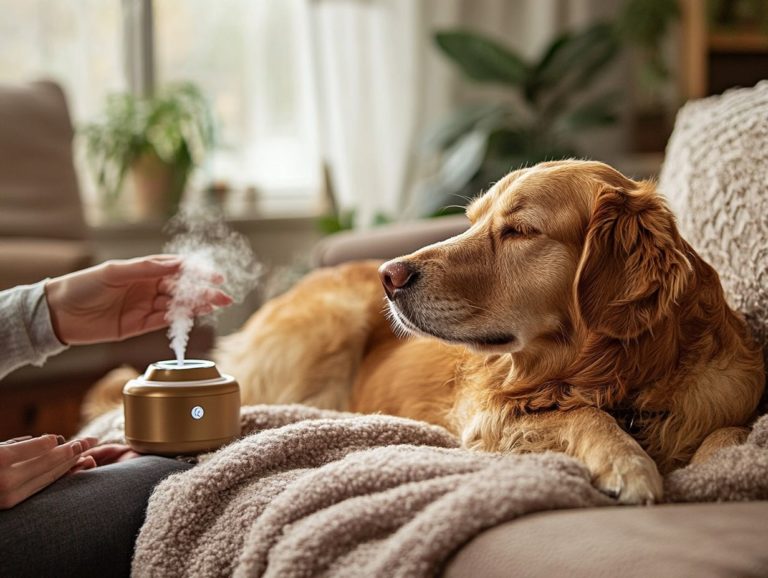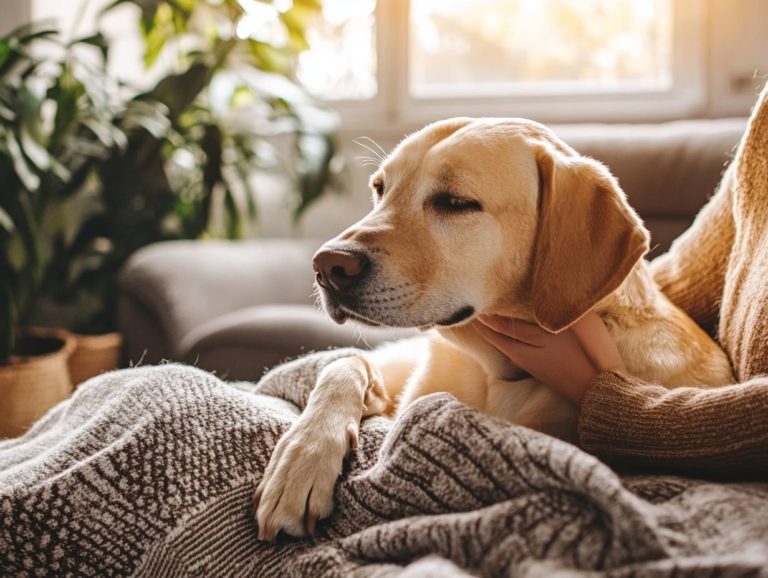10 Warning Signs of Pet Anxiety
It’s crucial to understand your pet’s behavior to keep them happy and healthy. Just like us, pets can experience anxiety, which can show up in various ways.
This article delves into ten warning signs that might suggest your furry friend is feeling stressed or anxious. From excessive barking and meowing to shifts in eating habits, recognizing these signs early on allows you to take proactive steps.
Moreover, we’ll explore the underlying causes of pet anxiety, how to diagnose it effectively, and the treatment options available to support your cherished companion.
Contents
- Key Takeaways:
- 1. Excessive Barking or Meowing
- 2. Destructive Behavior
- 3. Changes in Eating Habits
- 4. Hiding or Avoiding Interaction
- 5. Excessive Licking or Grooming
- 6. Aggression or Fearfulness
- 7. Changes in Sleeping Patterns
- 8. Excessive Panting or Drooling
- 9. Inappropriate Elimination
- 10. Excessive Shedding
- What Causes Pet Anxiety?
- Frequently Asked Questions
Key Takeaways:

- Excessive barking or meowing may be a sign of separation anxiety and should not be ignored.
- Destructive behavior, such as chewing or scratching, can also indicate pet anxiety and should be addressed promptly.
- Changes in eating habits, such as loss of appetite, can be a warning sign of pet anxiety and should be taken seriously.
1. Excessive Barking or Meowing
Excessive barking or meowing in your pets can be a clear sign of underlying anxiety, often pointing to issues like separation anxiety or fear-related concerns. Learning how to recognize and address anxiety in pets is essential for ensuring your furry companion’s mental well-being and proper conduct.
Various triggers might be at play, such as unfamiliar environments, loud noises, or even shifts in routine. According to the American Kennel Club (AKC), understanding the root of this anxiety is vital for pet owners who want to help their beloved companions. The Merck Veterinary Manual highlights that even minor stressors can escalate into significant vocalization issues if not managed appropriately.
Try positive reinforcement and calming aids, such as pheromone diffusers, to help ease your pet s anxiety. By being attuned to these factors, you can create a calmer, more balanced environment for your pets, making life more harmonious for both of you.
2. Destructive Behavior
Destructive behavior in dogs often stems from anxiety, particularly separation anxiety. This issue can escalate if not effectively addressed with appropriate training strategies and anxiety treatment options.
You might notice common signs of this anxiety manifesting as excessive chewing, digging, or inappropriate barking behaviors that reveal your dog’s struggle to cope with stressful situations. Similarly, for cat owners, being aware of 5 signs your cat may be anxious is vital, as it enables you to identify patterns and implement preventive measures.
Utilizing strategies such as creating a safe space, providing engaging distractions, or consulting a professional dog trainer can greatly help in alleviating anxiety. Resources like Waggel and the Canine Health Foundation provide valuable insights and tools for those looking to cultivate a more balanced and comfortable environment for their furry companions.
3. Changes in Eating Habits
Changes in your dog s eating habits can often be a red flag signaling anxiety. You might notice symptoms manifesting in various ways, such as a decreased appetite or sudden overeating, which can also relate to cognitive dysfunction syndrome in older pets.
When your canine companion is anxious, signs of distress may extend beyond mealtime. You might observe excessive panting, pacing, or even destructive behaviors. This can create a vicious cycle where anxiety impacts their nutritional intake, leading to further health issues like weight gain or malnutrition.
It’s vital for dog owners to seek veterinary advice when they notice these changes. A professional can help identify the underlying causes and recommend tailored treatment plans. These plans may include behavioral interventions, environmental modifications, and specific dietary adjustments to ensure the emotional and physical well-being of your furry friend.
If you observe any signs of anxiety in your pet, don’t hesitate to take action and consult a veterinarian for guidance. You can also explore 10 ways to help your pet cope with anxiety for additional support.
4. Hiding or Avoiding Interaction
Dogs that hide or avoid interaction often feel anxious, especially due to fear. This anxiety can hinder their ability to socialize with people and other pets.
Understanding these feelings is vital for you as a pet owner. When faced with anxiety triggers, these dogs may seek refuge in comforting spaces, craving relief from overwhelming situations.
Make gentle interactions a priority to boost your dog’s confidence! Use positive reinforcement techniques to build trust and create a safe environment for exploration.
Introduce new experiences gradually. This will help your dog get used to various stimuli without feeling overwhelmed. Your patience and empathy will be essential in guiding them towards emotional security.
5. Excessive Licking or Grooming
If your dog is licking or grooming themselves a lot, it might be a sign of anxiety. This behavior can stem from loud noises or changes in their routine.
It’s important to identify what might be causing this discomfort. Common environmental triggers include separation anxiety and sudden changes in their surroundings.
Consider natural therapies like CBD oil to promote relaxation. Offer anxiety wraps that provide gentle pressure to soothe your dog during stressful moments. Integrating these into your pet s routine can create a calmer environment.
6. Aggression or Fearfulness

Aggression or fear in dogs often indicates underlying anxiety. You may see behaviors like growling or cowering when they face unfamiliar situations.
Socialization is crucial for helping dogs adjust. By exposing them to different stimuli in a positive way, you can help them get used to new environments and reduce anxiety-induced reactions.
Collaborate with experienced dog trainers. They can customize training methods to create a supportive environment, guiding your dog to manage their fears and minimize aggressive responses.
7. Changes in Sleeping Patterns
If your dog is having trouble sleeping or is sleeping too much, it could indicate anxiety. This is especially true for older dogs with cognitive issues.
Anxiety may stem from changes in their home environment or loud noises, and it’s crucial for you to recognize signs your pet needs expert help for anxiety to enhance your furry friend’s quality of life.
Create a calming atmosphere by establishing a consistent daily routine with regular exercise, which can significantly ease anxiety symptoms.
Offer a balanced diet rich in omega fatty acids to support brain health and improve sleep. Simple changes, like a cozy sleeping space and relaxing activities, can foster a more tranquil night s rest.
Recognizing these signs early can greatly improve your dog s well-being. Don’t wait to help them feel safe!
8. Excessive Panting or Drooling
Excessive panting or drooling in dogs can often be misunderstood as indicators of health problems. However, these behaviors frequently point to underlying anxiety. Various anxiety symptoms demand prompt veterinary attention for an accurate diagnosis.
When your dog experiences anxiety, its body undergoes significant changes. An increased heart rate and heightened adrenaline production can lead to rapid breathing and excessive drooling. These reactions signal distress and can lead to dehydration if ignored.
It s crucial to recognize these signs and consult a local veterinarian for guidance.
Working with skilled veterinarians ensures a thorough evaluation of your dog s condition. This paves the way for tailored treatment options that help alleviate distressing behaviors and promote your pet’s overall well-being. Medications such as fluoxetine or clomipramine may be considered if necessary.
9. Inappropriate Elimination
Inappropriate elimination behaviors in dogs often stem from anxiety and manifest as stress-induced accidents. These can complicate your house-training efforts. To resolve this, effective training strategies are essential.
Understanding your dog’s specific anxiety triggers is crucial. Factors like changes in their environment, loud noises, or separation from you can elevate their stress. By identifying these triggers, you can take proactive steps to mitigate them.
A safe space for your dog can greatly ease anxiety. Regular exercise and mental stimulation are invaluable as well, helping to alleviate stress and enhance overall behavior. Establishing a consistent routine aids in successful house-training, as dogs thrive on the predictability and stability of a structured daily life.
10. Excessive Shedding
Excessive shedding in dogs may signal a physical reaction to anxiety, where your canine companion’s stress manifests as increased hair loss. Stress typically worsens this problem, making it essential to implement effective stress management strategies to alleviate the issue.
Recognizing this connection is vital for you as a pet owner who desires to cultivate a healthier environment for your furry friend. When dogs experience heightened anxiety whether from changes in their surroundings or loud noises their bodies react in ways that can visibly distress.
Addressing shedding goes beyond collecting fur from your floors; it s an opportunity to delve into stress management techniques. Regular exercise significantly alleviates anxiety levels, offering an outlet for pent-up energy while boosting confidence.
A well-balanced diet rich in essential nutrients plays a crucial role in supporting overall health, positively impacting coat quality. Consulting with a veterinarian can provide you with personalized solutions tailored to your dog s specific needs, ensuring that both mental and physical well-being are prioritized.
What Causes Pet Anxiety?
Pet anxiety can stem from a range of factors, including environmental stressors, insufficient socialization, and negative past experiences. Understanding the dangers of ignoring pet anxiety is essential for you to recognize these anxiety triggers and implement effective training strategies to create a supportive environment for your pet.
These triggers often emerge from changes in routine, such as moving to a new home, welcoming new family members, or shifts in daily schedules. Loud noises like thunderstorms or fireworks can leave a lasting impact, intensifying your pet’s unease.
Consistent socialization and gradual exposure to new experiences can help alleviate these reactions. Behavioral signs, such as excessive barking or hiding, can guide you in identifying if your pet has anxiety effectively, ensuring a calmer and more secure atmosphere for both you and your furry companion.
How Can Pet Owners Help Their Anxious Pets?

Act now to help your anxious pets thrive with effective strategies! You can support your pets by exploring various anxiety treatment options, utilizing calming aids, and adopting training strategies that promote comfort and security.
One effective approach is using pheromone diffusers. These emit calming scents to create a serene environment for your pet. Anxiety wraps are another great tool; they apply gentle pressure that mimics the comforting feeling of being held, alleviating stress significantly.
Natural therapies, like CBD oil a natural oil derived from hemp that may help reduce anxiety have gained popularity among caregivers who prefer natural options. Establishing consistent routines and using positive reinforcement during training can foster trust and stability, helping your pets feel more secure.
What Are the Different Types of Pet Anxiety?
Understanding the various types of pet anxiety like separation anxiety and fear-related anxiety enables you to identify specific symptoms and create effective treatment plans tailored to your dog.
Recognizing these forms of anxiety allows for a more personalized approach. For instance, separation anxiety occurs when your dog experiences intense distress when left alone, leading to destructive behaviors or excessive barking. In contrast, fear-related anxiety may emerge in response to loud noises or unfamiliar situations, causing your dog to cower or even act aggressively.
Each type requires unique insights for effective management. Separation anxiety can often be eased through gradual desensitization and positive reinforcement. Fear-related anxiety may benefit from counter-conditioning techniques or calming aids.
By grasping these nuances, you can create a safer, more supportive environment for your beloved furry companion.
How Can Pet Anxiety Be Diagnosed?
Diagnosing pet anxiety starts with keenly observing behavioral changes and consulting trusted resources, like the veterinary manual, to pinpoint anxiety symptoms and develop a holistic treatment plan tailored to your pet s needs.
The journey typically begins with a comprehensive consultation with veterinarians, who can provide valuable insights into both the physical and psychological aspects of your pet’s health. Take note of specific behaviors like excessive barking, signs of distress, or shifts in eating habits, as these can be telltale indicators of anxiety in older pets.
It’s crucial to rule out other medical conditions, as these can mimic anxiety symptoms and may require different treatment approaches. Engaging with professional dog trainers can also be incredibly helpful; they can provide structured training that alleviates anxiety while reinforcing positive behaviors, enhancing your pet’s overall well-being.
What Are the Available Treatment Options for Pet Anxiety?
You ll find a variety of treatment options for pet anxiety, from anxiety medications like SSRIs and benzodiazepines to natural therapies and behavioral training techniques that promote long-term mental well-being.
These treatments can be customized to meet the unique needs of each animal since what works for one may not work for another. Some pets might thrive on pharmaceutical interventions like fluoxetine or clomipramine, which help regulate mood and alleviate anxiety.
On the flip side, embracing non-pharmaceutical approaches like regular exercise, a balanced diet, and calming aids such as aromatherapy or supportive toys can also yield impressive results.
Partnering with your vet is key to finding the best solution for your furry friend! Work closely with them to develop individualized treatment plans that address both immediate symptoms and underlying issues, ensuring a holistic approach to your pet s mental health.
How Can Pet Owners Prevent Pet Anxiety?
Preventing pet anxiety calls for proactive measures. This means ensuring proper social interactions, effective training, and keeping a regular schedule that includes exercise and healthy food. All these factors support your dog s overall mental well-being.
Early interactions with other dogs and exposure to various environments can significantly enhance your dog s adaptability. This helps reduce potential anxiety triggers later in life. Regular playdates or puppy classes foster confidence, helping them learn to navigate social situations with ease.
Incorporate daily exercise. It doesn t just burn off excess energy; it also promotes the release of feel-good hormones that elevate mood and enhance overall stability.
A balanced diet rich in essential nutrients plays a crucial role in your pet s emotional health, contributing to a calm demeanor and minimizing stress-related behaviors.
Frequently Asked Questions
What are the top 10 warning signs of pet anxiety?

The top 10 warning signs of pet anxiety include:
- Excessive barking or meowing
- Destructive behavior
- Changes in appetite
- Excessive licking or grooming
- Hiding or avoidance
- Changes in sleeping patterns
- Aggression
- Trembling or shaking
- Changes in bathroom habits
- Constant pacing or restlessness
How can I tell if my pet is experiencing anxiety?
You can tell if your pet is experiencing anxiety by observing their behavior for any of the signs your pet needs help with anxiety mentioned above. It’s important to note any changes in their behavior, as well as any triggers that may be causing their anxiety.
What can I do to help my pet if they are showing signs of anxiety?
You can take exciting steps to help your pet feel better! These include providing a safe and comfortable environment, ensuring they have enough physical exercise, creating a routine, seeking professional help, and using calming aids like natural supplements.
Can pet anxiety be treated?
Yes, you can help your pet experience less anxiety! With proper management and training, many pets can learn to cope with their anxiety and improve their behavior. In some cases, a veterinarian may prescribe medication to help alleviate severe symptoms.
Are certain pets more prone to anxiety than others?
Yes, some pets may be more prone to anxiety, such as rescue pets who have experienced trauma in their past. Additionally, certain breeds, like herding dogs, may be more susceptible to anxiety due to their high energy levels and need for mental stimulation.
Can I prevent my pet from developing anxiety?
While some pets may be more prone to anxiety than others, there are steps you can take to help prevent it. Start with early socialization, provide plenty of mental and physical stimulation, and maintain a consistent routine. Be aware of any triggers that may cause your pet to feel anxious and address them promptly.
Start today to create a happy and calm environment for your furry friend!






